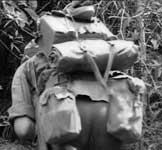Web Infantry Equipment, Pattern 1944
Equipment and Equipment Carriers: Water Bottles and Carriers
Stores Ref. A6/AF 0025 Bottle, water, aluminium
Stores Ref. A1/AA 0342 Bottle, water, aluminium
Stores Ref. CN/AA 0342 Web Equipment Patt. ’44, Bottle, water, aluminium

 This was a direct “steal” from U.S. M-1910 design, but modified to have a wider diameter neck, a bigger capacity, revised handle design and with the body constructed seamlessly. The prototype, shown in official photos below right, had a chained, “flat top” Cap and the handles lacked the kink in the upper arms, which enabled them to be locked together. Early production, as shown at left, retained the chained Cap, but added the kinks. No introductory documentation has been found, but when approval was given on 9th April, 1946, Part 3 of LoC §C2311 already shows a further change, the chain having been deleted, in favour of a cord. This LoC transferred the Bottle, Cup and Carrier from V.A.O.S. Section A6 Jungle Equipment, to Section A1, as a General Service items. It also now changed from an assembly code A6/AF 0025, covering Bottle, Cap and Cup, to separate codes for the three items. Part 3 details the complete Bottle as “…Complete
This was a direct “steal” from U.S. M-1910 design, but modified to have a wider diameter neck, a bigger capacity, revised handle design and with the body constructed seamlessly. The prototype, shown in official photos below right, had a chained, “flat top” Cap and the handles lacked the kink in the upper arms, which enabled them to be locked together. Early production, as shown at left, retained the chained Cap, but added the kinks. No introductory documentation has been found, but when approval was given on 9th April, 1946, Part 3 of LoC §C2311 already shows a further change, the chain having been deleted, in favour of a cord. This LoC transferred the Bottle, Cup and Carrier from V.A.O.S. Section A6 Jungle Equipment, to Section A1, as a General Service items. It also now changed from an assembly code A6/AF 0025, covering Bottle, Cap and Cup, to separate codes for the three items. Part 3 details the complete Bottle as “…Complete 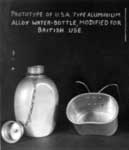
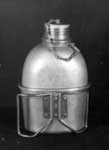 with stainless steel screwed cap, secured by nylon cord, and aluminium cup; previously listed under Cat. A.F. 0025…”, The Bottle now became A1/AA 0342. Plate II of the Fitting Instructions illustrate the Bottle, its chained Cap and the Cup, but does not list them, as they were, by then, part of Section A1. LoC §C4686 then included it as “Web Equipment” which, being aluminium, it plainly could not be! Where the Bottle and Cup were aluminium, the bottle Cap was stainless steel, with abbreviated pressed ribs for grip and with its rim flared. A rubber washer was fitted round the neck and the flare sealed down onto this. A loose riveted loop was again fitted, now for the attachment of a cord. The original wire ring, with twisted eye is absent on the example illustrated, but would have served to tie-on the cord. Later, at a date not yet determined, a moulded rubber Cap, with a disc washer inside, was also used, though apparently never coded. For this, the neck of the Bottle was made taller, a watertight seal now being made between the underside of the Cap and the rim of the bottle neck. Bottle shown left above from the Terry Hawker Collection, photographs © Terry Hawker and Cathy Davis 2012. The Cup in these photos is maker marked "MMS" and dated 1945. Official photographs of the prototype Bottle and Cup provided to Karkee Web by Clive Law.
with stainless steel screwed cap, secured by nylon cord, and aluminium cup; previously listed under Cat. A.F. 0025…”, The Bottle now became A1/AA 0342. Plate II of the Fitting Instructions illustrate the Bottle, its chained Cap and the Cup, but does not list them, as they were, by then, part of Section A1. LoC §C4686 then included it as “Web Equipment” which, being aluminium, it plainly could not be! Where the Bottle and Cup were aluminium, the bottle Cap was stainless steel, with abbreviated pressed ribs for grip and with its rim flared. A rubber washer was fitted round the neck and the flare sealed down onto this. A loose riveted loop was again fitted, now for the attachment of a cord. The original wire ring, with twisted eye is absent on the example illustrated, but would have served to tie-on the cord. Later, at a date not yet determined, a moulded rubber Cap, with a disc washer inside, was also used, though apparently never coded. For this, the neck of the Bottle was made taller, a watertight seal now being made between the underside of the Cap and the rim of the bottle neck. Bottle shown left above from the Terry Hawker Collection, photographs © Terry Hawker and Cathy Davis 2012. The Cup in these photos is maker marked "MMS" and dated 1945. Official photographs of the prototype Bottle and Cup provided to Karkee Web by Clive Law.
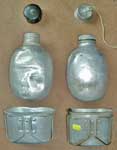 The photo at left shows Bottles with both the early (stainless steel) and late (plastic) Caps. Also note the bit of insulating tape on the Cup at right. This was a common soldiers' mod - to keep from burning your lips with that hot cuppa! Both from the Rog Dennis Collection, photos © Rog Dennis 2009.
The photo at left shows Bottles with both the early (stainless steel) and late (plastic) Caps. Also note the bit of insulating tape on the Cup at right. This was a common soldiers' mod - to keep from burning your lips with that hot cuppa! Both from the Rog Dennis Collection, photos © Rog Dennis 2009.
Stores Ref. A6/AF 0026 Cup, bottle, water, aluminium
Stores Ref. A1/AA 0790 Cup, bottle, water, aluminium
Stores Ref. CN/AA 0790 Web Equipment Patt. ’44, Cup, water bottle, aluminium
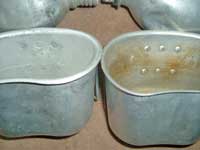
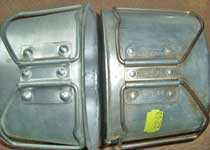
 The Cup was different to its U.S. equivalent, having handles officially termed as “…butterfly…”. These were of rectangular form, riveted to hinge on a vertical line, though later the handles incorporated slight kinks, on the upper arms, that allowed the two handles to be brought together, overlapped and locked together. It would prove a favourite component, troops preferring it to the nylon cup provided with Patt. ’58 W.E. You could not boil water in a nylon cup, so after Patt. ’44 became obsolete, a new aluminium cup, with indented capacity marks, was introduced for troops on Cold Weather operations. Note the word order of “bottle” and “water” changed with LoC §C4686.
The Cup was different to its U.S. equivalent, having handles officially termed as “…butterfly…”. These were of rectangular form, riveted to hinge on a vertical line, though later the handles incorporated slight kinks, on the upper arms, that allowed the two handles to be brought together, overlapped and locked together. It would prove a favourite component, troops preferring it to the nylon cup provided with Patt. ’58 W.E. You could not boil water in a nylon cup, so after Patt. ’44 became obsolete, a new aluminium cup, with indented capacity marks, was introduced for troops on Cold Weather operations. Note the word order of “bottle” and “water” changed with LoC §C4686.
The two Cups in the photos far and centre left above have different styles of rivets - these are presumably manufacturing differences of no great significance. The photo near left above shows that this Cup is marked with the date (1964), the CN code, and "PATT 44". All from the Rog Dennis Collection, photos © Rog Dennis 2009.
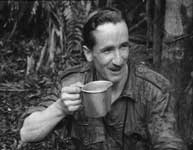
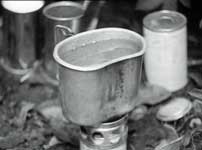 At right, the Cup, bottle, water, aluminium, observed in its natural habitat. Brewing up on jungle patrol, with the 1st Battalion, Worcester Regiment, in Malaya, 1953. In the picture near right, the Cup is setting on a commercial "Tommy Cooker". In both of these photos, note that its handles are locked together, as described above.
At right, the Cup, bottle, water, aluminium, observed in its natural habitat. Brewing up on jungle patrol, with the 1st Battalion, Worcester Regiment, in Malaya, 1953. In the picture near right, the Cup is setting on a commercial "Tommy Cooker". In both of these photos, note that its handles are locked together, as described above.
Stores Ref. CN 2287 Cap, S.S., c/w loop for cord
Stores Ref. CN 2288 Cord, nylon, 14-in. lengths
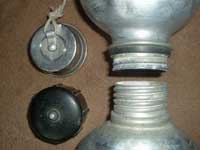 In its original form, the top of the Cap was completely flat. A chain was permanently attached to a revolving link, riveted in the centre of the cap. An oversized, brazed wire ring was slipped over the bottle neck and tightened by being twisted into an eye for the chain. At some point, the centre part of the cap was formed into a circular depression, around which the link was free to revolve. LoC §C4686, approved 10 April 1951, created these two codes, for Web equipment patt. ’44 repair items. (note the lack of capitals). They had not previously been coded in Section A1, instead being accounted for as Bottles… Complete with… With no Old Code, the New Code was simply “CN” and not “CN/AA”, as with the rest of the component parts.
In its original form, the top of the Cap was completely flat. A chain was permanently attached to a revolving link, riveted in the centre of the cap. An oversized, brazed wire ring was slipped over the bottle neck and tightened by being twisted into an eye for the chain. At some point, the centre part of the cap was formed into a circular depression, around which the link was free to revolve. LoC §C4686, approved 10 April 1951, created these two codes, for Web equipment patt. ’44 repair items. (note the lack of capitals). They had not previously been coded in Section A1, instead being accounted for as Bottles… Complete with… With no Old Code, the New Code was simply “CN” and not “CN/AA”, as with the rest of the component parts.
No reason is known for the U.S. style chain being abandoned. When in place in the Carrier, the chain would not rattle, but when being done up / undone, the chain could scrape on the bottle body. Any un-necessary, inherent noise is un-desirable in military products. Perhaps this was why a “silent” cord was adopted. Similarly, no code or nomenclature, or date of introduction has been found for the rubber cap, hence the italics. The stainless steel Cap tended to screech, when it was rotated, so perhaps the rubber cap was the “stealth” version!
The photo at left shows a comparison of the Bottles and Caps. As can be seen, the neck of the later Bottle has a longer threaded area, presumably to accomodate the plastic Cap. Note the nylon cord. Also note that, on the plastic Cap, the swivelling cord attachment is missing, the rivet having sprung. Both from the Rog Dennis Collection, photos © Rog Dennis 2009.
Stores Ref. A6/AF 0044 Carrier, waterbottle, W.E. Patt. ’44
Stores Ref. A1/AA 0577 Carrier, waterbottle, W.E. Patt. ’44 (LoC C 2311 April 1946)
Stores Ref. A1/AF 0577 Cover, bottle, water, aluminium (F.I.s June 1946)
Stores Ref. A1/AA 0577 Cover, waterbottle (Infy. Bulletin June 1947)
Stores Ref. A1/AA 0577 Carrier, water bottle, W.E. Patt. ’44 (LoC C 4686 1951)
Stores Ref. CN/AA 0577 Web Equipment Patt. ’44, Carrier, water bottle (LoC C 4686 1951)
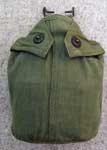
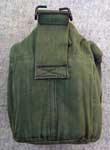
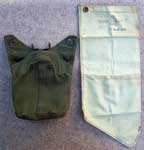 The Army seem to have had some trouble with this item, as witness its various nomenclatures, not to say codes, across time and source document. LoC §C2311 allocated a new AA code of 0577, yet the Fitting Instructions, dated two months later, gives it AF 0577 and suddenly calls it a Cover, in the manner of the felt Covers previously in use! One year on and Infantry Bulletin No. 44 still calls it a Cover. Four years later, the Old Designation, in LoC §C4686, gives Carrier again, on the authority of LoC §C2311. Clearly, it was a Carrier all along and the AF prefix in the Fitting Instructions was an error.
The Army seem to have had some trouble with this item, as witness its various nomenclatures, not to say codes, across time and source document. LoC §C2311 allocated a new AA code of 0577, yet the Fitting Instructions, dated two months later, gives it AF 0577 and suddenly calls it a Cover, in the manner of the felt Covers previously in use! One year on and Infantry Bulletin No. 44 still calls it a Cover. Four years later, the Old Designation, in LoC §C4686, gives Carrier again, on the authority of LoC §C2311. Clearly, it was a Carrier all along and the AF prefix in the Fitting Instructions was an error.
Again a “steal” from the U.S. M-1910 design, it was un-insulated and made large enough to hold other items. On the rear inside wall, a flapped sleeve could hold a folded Bag, water, filter, or “Millbank” Bag (Stores Ref. A6/AF 0005) and a loop in the base seam held a bottle of purifying tablets. A long belt loop was fitted to the rear face, its upper end pinched up to hold a hanger hook, thus providing high, or low attachment. As with the Bottle, the Carrier was carried over into use with Patt. ’58 W.E., which had neither a Bottle, nor a Carrier, when it was introduced in 1959. The Carrier shown here is maker marked "M.E. Co." and dated 1945, while the Water filter bag is maker marked "Waring & Gillow Ltd.", and also dated 1945. Both are from the David Gordon Collection. Photos © David Gordon 2009.
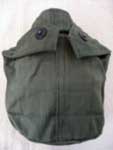
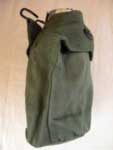
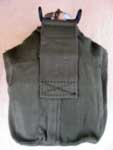
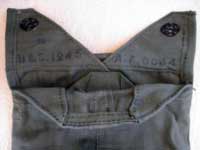 Another example, this one maker marked "H & S." and dated 1945. From the Terry Hawker Collection, photos © Terry Hawker and Cathy Davis 2012.
Another example, this one maker marked "H & S." and dated 1945. From the Terry Hawker Collection, photos © Terry Hawker and Cathy Davis 2012.
As can be seen, the assembly of Bottle, Cup and Carrier remained out of sequence, even when transferred to V.A.O.S. Section A1 and thence to C.C.N. Section CN. Only when NSN codes were allocated was the Bottle, etc placed in sequence.
